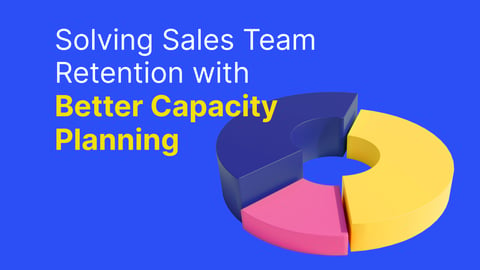Sales leaders and managers, in this blog we’re addressing (and providing some solutions for) your biggest challenges with territory planning. This part of sales can often feel like going to war, or at the very least, into battle. As the territory allocation process kicks off, you’re surrounded by maps, marketing strategy documents, and technical product details, while also handling human issues such as quota allocation queries or discrepancies on commission statements from your sales team. In short, sales territory planning is “a lot”. And sometimes, even that planning element can be more all-consuming than you’d have imagined, when all you really want your team to do is start selling. This article should not only rub healing ointment (and possible software solutions) onto your territory planning pain, but it will also address other challenges such as how to deal with inflexible and outdated systems, failing IT systems, and shadow planning (aka the evil twin of shadow accounting).
The Trouble with Territory Planning
All business moves start with a robust plan, right? You even may be familiar with some of the quotes from celebrated leaders that celebrate the virtues of planning – many of which were coined in times of war or hardship. There’s Benjamin Franklin who was responsible for saying “By failing to prepare, you are preparing to fail” and former US President Dwight D Eisenhower who claimed that “In preparing for battle I have always found that plans are useless, but planning is indispensable.”
Both quotes are inspiring and motivational for sure, but did either of these historical legends ever roll out a territory planning strategy using a set of corrupted and error-strewn Excel spreadsheets? Or decide the physical boundaries and resources for a sales region while juggling a paper map and some sales management performance (SPM) records? That would be a hard “no”.
Quotes aside, for now, it’s time to revisit some of the most common territory planning challenges known to sales leaders before offering up solutions.
1. Overcoming Spreadsheet Anxiety
There was a time not so long ago when almost every element of sales activity, finance, and management was created via a spreadsheet. In fact, reports suggest that around 82 percent of sales organizations still have some dependency on Excel when it comes to territory planning, so this isn’t consigned to history just yet. So, what has been going badly for spreadsheet packages? This level of reliance and activity presents problems with data error, systems crashing, cells corrupting and staff revolting – which was often the outcome when all that inaccuracy resulted in over-resourced sales territories and quota mismanagement. The ownership of these precious spreadsheets was often down to the sales leader, who at the same time was dealing with all those other data sources concerning commission, holidays, and absenteeism. All this critical information had the potential to conflict and create chaos. There are also technical issues. Whether you’re a one-person-sales-team or heading up a team in the hundreds, there’s nothing more likely to set your teeth on edge than a crashing computer – especially if you’re midway through uploading or reviewing detailed records. This wide margin for computer error can set you back weeks on your territory planning. To summarize, even with the most strategic, calm brain at the Excel helm, that still left a lot of room for technical downtime, inputting mistakes, and panic.
2. Out-of-date Data
Let’s now add another layer of concern to that thick cake of sales territory challenges – that of outdated data coming from your Customer Relationship Management (CRM) system. You’re now at a stage where you can start to use your customer and product data to paint a picture of where you must concentrate efforts, and if you need to create new territories. Size, sales resourcing, account numbers, and potential for compensation and bonuses hinge on the quality and relevance of data you’re using. If your customer records are still filled with those who have opted out from further communications, you’re not just wasting time and people chasing these prospects, but also in breach of data laws, which is a whole other worry. If you’re utilizing product sales records to inform your territory planning, the same logic applies; the words and figures need to be correct and recent. Disconnected and dated data storage and retrieval systems will give you garbage, and you run the risk of allocating a strong team to the wrong territory which also skews targets.
3. Terrible Territorial Decisions
The biggest challenge is what occurs as and when you finalize territorial boundaries. Without the wisdom of accurate reporting, robust software, and solid metrics to guide you, you may as well close your eyes and stick a pin just about anywhere on the map. When you’re under the combined weight of stakeholders, product managers, and sales professionals’ expectations, all of whom have slightly different reasons and motives for getting the sales pipeline going, it’s possible to make a hasty decision on slicing up sales territories. These wrong turns could result in:
- Over-saturating a region so your team is under-worked and can’t achieve targets or commission
- An incomplete picture of competition
- Territories sometimes secured on geography alone rather than the size of the account
- Whole areas and possible territories being completely missed due to incomplete data
- Under-resourcing a territory so local teams are overstretched
- Not understanding desire (or lack of) for a product or proposition
- Team members losing faith, which increases incidents of shadow planning.
These challenges to getting the sales territory success recipe correct are not insignificant. Add in unexpected fluctuations to the market or a pandemic that can really shatter your traditional territory planning model, and you have good reason to review. But these scenarios are not insurmountable. With the solution and by implementing software that supports your territory planning, all the above can be avoided.
One Single Source of Truth – the Software Solution to Your Challenges
We’re going to be blunt here and recommend that before anything else, you scrap the spreadsheet methodology altogether. It leaves you exposed to error, it’s unreliable and nobody is genuinely a fan of picking through minute lines of cells and numbers. From now on, the most valuable item in your updated sales territory armory is an integrated, customizable territory and quota “management product, such as the one we offer at Varicent. Our Incentive Compensation Management software is accessible to all those involved in the sales territory planning journey and brings every element of reporting, metrics, and planning into one single source of truth. In one single implementation, you’re banishing all the woes and worries that come together with conflicting software and data-gathering sources.
And what does this clever functionality give you in the planning stakes? With smart mapping software, you’ll be able to create “what if” scenarios to mitigate for any circumstances, spot early on if a territory is underperforming, and use the results as part of a wider SPM conversation with your team members. You can also use analytics and reporting to ensure quota allocations are equitable and make sure that your sales team is better aligned with prospects.
A software solution such as this is also built to reduce technical downtime. While aging systems are constantly crashing or reaching data limits, a piece of reliable software will expand with your requirements without blowing the company fuse box.
Discover some more great tips from Varicent for building a better sales territory plan here.
Talking, Sharing, Motivating – the Other Side of the Solution
While the suggested software solution will go a long way to eradicating your sales territory challenges, there are additionally some more human answers to common problems. The better you know your sales team and their individual strengths and weaknesses, the higher the chances you can assign them to the territory that will pair with their skills. SPM software can provide tangible records and progress, but regular conversations and performance reviews will give you a much clearer picture of how they are getting on. This personal interaction is also necessary for sharing any sudden changes in sales direction or marketing strategy, rather than them seeing this on a company-wide email when a decision may well be irreversible.
The last part of this essential triad is the power of motivation. Making a sales professional believe that they are making a difference can only be effectively achieved through direct communication and the strength of your company’s Incentive Compensation Management (ICM) plan. By demonstrating the rigor and rationale of your sales territory planning, you’re giving your team a chance to provide feedback and an opportunity to really push for a sales ideology that they can get behind. It can be hard when posted to the frozen wastelands of a distant region, so make sure that any revised or new territories provide ample opportunity to chase fresh prospects, so that your sales team constantly feels inspired, not tired.
Even the best sales territory plans in the most capable of leadership hands will need to be adapted at some point, but by implementing Territory and Quota Planning Software you’ll be more empowered, adaptable, and ready for change when and if it comes.
To end on a final quote that will make perfect sense for all good sales leaders.
“A goal without a plan is just a wish” Antoine de Saint-Exupery, author, and philosopher.
Discover the full capabilities of Varicent’s solution by booking a demo today.




